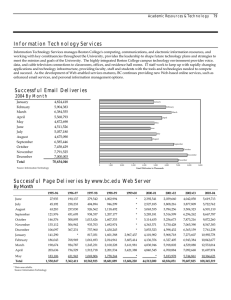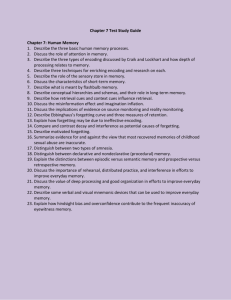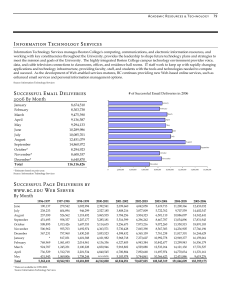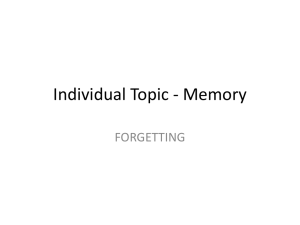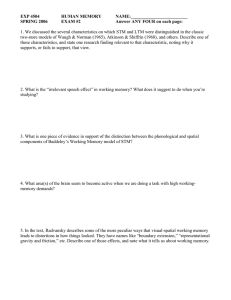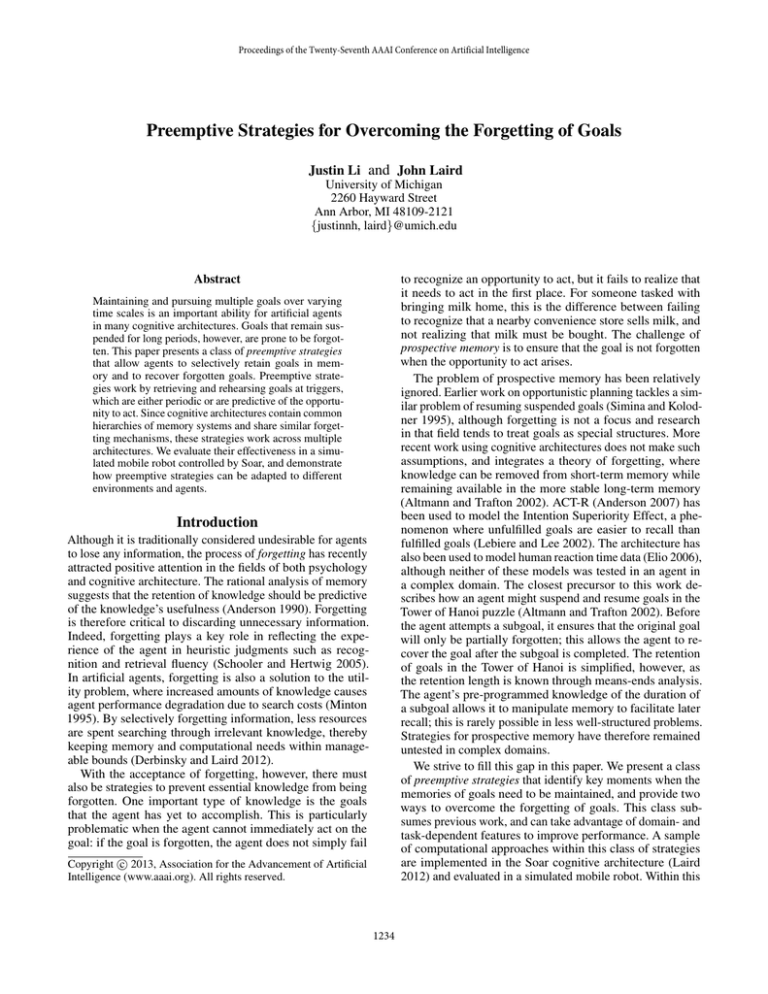
Proceedings of the Twenty-Seventh AAAI Conference on Artificial Intelligence
Preemptive Strategies for Overcoming the Forgetting of Goals
Justin Li and John Laird
University of Michigan
2260 Hayward Street
Ann Arbor, MI 48109-2121
{justinnh, laird}@umich.edu
Abstract
to recognize an opportunity to act, but it fails to realize that
it needs to act in the first place. For someone tasked with
bringing milk home, this is the difference between failing
to recognize that a nearby convenience store sells milk, and
not realizing that milk must be bought. The challenge of
prospective memory is to ensure that the goal is not forgotten
when the opportunity to act arises.
The problem of prospective memory has been relatively
ignored. Earlier work on opportunistic planning tackles a similar problem of resuming suspended goals (Simina and Kolodner 1995), although forgetting is not a focus and research
in that field tends to treat goals as special structures. More
recent work using cognitive architectures does not make such
assumptions, and integrates a theory of forgetting, where
knowledge can be removed from short-term memory while
remaining available in the more stable long-term memory
(Altmann and Trafton 2002). ACT-R (Anderson 2007) has
been used to model the Intention Superiority Effect, a phenomenon where unfulfilled goals are easier to recall than
fulfilled goals (Lebiere and Lee 2002). The architecture has
also been used to model human reaction time data (Elio 2006),
although neither of these models was tested in an agent in
a complex domain. The closest precursor to this work describes how an agent might suspend and resume goals in the
Tower of Hanoi puzzle (Altmann and Trafton 2002). Before
the agent attempts a subgoal, it ensures that the original goal
will only be partially forgotten; this allows the agent to recover the goal after the subgoal is completed. The retention
of goals in the Tower of Hanoi is simplified, however, as
the retention length is known through means-ends analysis.
The agent’s pre-programmed knowledge of the duration of
a subgoal allows it to manipulate memory to facilitate later
recall; this is rarely possible in less well-structured problems.
Strategies for prospective memory have therefore remained
untested in complex domains.
We strive to fill this gap in this paper. We present a class
of preemptive strategies that identify key moments when the
memories of goals need to be maintained, and provide two
ways to overcome the forgetting of goals. This class subsumes previous work, and can take advantage of domain- and
task-dependent features to improve performance. A sample
of computational approaches within this class of strategies
are implemented in the Soar cognitive architecture (Laird
2012) and evaluated in a simulated mobile robot. Within this
Maintaining and pursuing multiple goals over varying
time scales is an important ability for artificial agents
in many cognitive architectures. Goals that remain suspended for long periods, however, are prone to be forgotten. This paper presents a class of preemptive strategies
that allow agents to selectively retain goals in memory and to recover forgotten goals. Preemptive strategies work by retrieving and rehearsing goals at triggers,
which are either periodic or are predictive of the opportunity to act. Since cognitive architectures contain common
hierarchies of memory systems and share similar forgetting mechanisms, these strategies work across multiple
architectures. We evaluate their effectiveness in a simulated mobile robot controlled by Soar, and demonstrate
how preemptive strategies can be adapted to different
environments and agents.
Introduction
Although it is traditionally considered undesirable for agents
to lose any information, the process of forgetting has recently
attracted positive attention in the fields of both psychology
and cognitive architecture. The rational analysis of memory
suggests that the retention of knowledge should be predictive
of the knowledge’s usefulness (Anderson 1990). Forgetting
is therefore critical to discarding unnecessary information.
Indeed, forgetting plays a key role in reflecting the experience of the agent in heuristic judgments such as recognition and retrieval fluency (Schooler and Hertwig 2005).
In artificial agents, forgetting is also a solution to the utility problem, where increased amounts of knowledge causes
agent performance degradation due to search costs (Minton
1995). By selectively forgetting information, less resources
are spent searching through irrelevant knowledge, thereby
keeping memory and computational needs within manageable bounds (Derbinsky and Laird 2012).
With the acceptance of forgetting, however, there must
also be strategies to prevent essential knowledge from being
forgotten. One important type of knowledge is the goals
that the agent has yet to accomplish. This is particularly
problematic when the agent cannot immediately act on the
goal: if the goal is forgotten, the agent does not simply fail
c 2013, Association for the Advancement of Artificial
Copyright Intelligence (www.aaai.org). All rights reserved.
1234
domain, we demonstrate that increasing the rate of forgetting
or slowing down the temporal dynamics makes prospective
memory more challenging, but that preemptive strategies can
adapt to these changes.
n
X
activation = ln(
ti −d )
i=1
Figure 1: The equation for base-level activation. n is the
number of activation boosts, ti is the time since the ith boost
occurred, and d is a free decay-rate parameter.
Forgetting and Memory Hierarchies
The goal of cognitive architecture research is to discover
the fundamental computational structures and processes that
underlie intelligent behavior. This paper focuses on two architectures, ACT-R and Soar, as they are fully implemented,
widely used, and share similarities in design. Both architectures create behavior through the matching of if-then rules:
the conditions test knowledge in memory, which the actions
transform or remove. More crucially, the two architectures
incorporate short-term and long-term memories. These memories form a hierarchy, with the levels arranged by the stability, the influence on behavior, and the amount of knowledge
contained. The memory elements stored in this hierarchy represent different kinds of knowledge, including the pending
goals of the agent; it is the forgetting of these goals that give
rise to the challenges of prospective memory.
At the top of the hierarchy is short-term or working memory. This memory contains the immediate perceptions of the
agent, as well as knowledge that is relevant to the current
situation. The knowledge in short-term memory directly determines the behavior of the agent, as it is the only knowledge
against which rules are matched. Since the size of short-term
memory is a major factor in the cost of rule-matching (Forgy
1979), it is usually kept small; an architectural limit may
be placed on its size (as in ACT-R), or an architectural process may remove memory elements over time (as in Soar).
Both of these mechanisms can be considered “forgetting”, as
potentially useful knowledge is lost.
At the next level of the memory hierarchy is one or more
long-term memories. This level of the hierarchy contains
knowledge that may be useful to the agent over its lifetime,
but not necessarily at the present; examples include facts
about the domain and the previous experiences of the agent.
Due to its potential size, rules do not match against knowledge in long-term memory. Instead, long-term knowledge
is accessed through deliberate cued-retrievals, where the results are deposited in specialized buffers in working memory.
Although knowledge in long-term memory does not directly
impact rule-matching costs, it may still be forgotten; whether
a particular memory element is lost is often a function of the
agent’s previous access to that knowledge.
The last level in the “memory” hierarchy is the environment, which we include for completeness. It is considered
a level in the hierarchy because knowledge that is lost from
long-term memory may be recoverable from the environment.
Since the environment is external to the agent, access to
knowledge is extremely slow as compared to other memories.
In this work, we do not consider how the agent can obtain
knowledge from the environment to combat forgetting.
Although other architectures may not fully implement this
memory hierarchy, a small subset of abilities is sufficient for
the rest of this paper to apply. In particular, the architecture
must have a working memory of limited size (eg. CHREST,
Polyscheme) or that is subject to forgetting (eg. CLARION,
LIDA), and must support directed memory retrievals (all of
the above) (Gobet and Lane 2010; Cassimatis et al. 2010;
Sun 2006; Snaider, McCall, and Franklin 2011). These two
capabilities are sufficient to implement some of the strategies
in this work, and many of the effects apply. The rest of this
paper focuses solely on ACT-R and Soar.
Forgetting in ACT-R and Soar
We now describe how ACT-R and Soar implement this memory hierarchy, and how forgetting affects the knowledge in
each architecture.
In ACT-R, knowledge is represented as chunks. Chunks are
stored and processed by modules, which perform specialized
operations such as perception, motor actions, and memory access. These modules are only accessible through their buffers,
each of which contains at most one chunk. The buffers of
all the modules together act as ACT-R’s working memory,
and they contain the only knowledge that rules can match
against and directly modify. Since the size and the number
of buffers is fixed, ACT-R’s working memory has limited
capacity; in order to access a module, the current contents
of its buffer must be replaced. To overcome this extremely
rapid forgetting of information from working memory, all
chunks that have existed in various buffers are automatically
stored into the declarative memory (DM) module. This module acts as ACT-R’s long-term memory, allowing knowledge
no longer available in working memory to be recovered. To
retrieve knowledge from declarative memory, the agent must
query DM with a partial description of the desired knowledge;
knowledge that best matches the description will be recreated in the buffer. A chunk in declarative memory may also
be forgotten, based on its base-level activation, which summarizes its access history (Figure 1). Activation decreases
exponentially over time, a process called decay, but is increased (boosted) whenever the chunk appears in a buffer,
either due to retrieval or due to perception from the environment. If the activation of a chunk falls below a threshold, the
chunk becomes unretrievable, and can only be boosted again
through perception. Forgetting in ACT-R therefore occurs on
two levels: knowledge may be lost in working memory due
to replacement by other knowledge, and knowledge may be
lost in declarative memory due to infrequent access.
In Soar, working memory is a graph structure with special
locations for perception and motor control, as well as for
accessing the long-term memories. Episodic memory stores
the previous experiences of the agent, while semantic memory stores knowledge and facts about the world. We focus
on semantic memory in this paper, due to its similarity with
ACT-R’s declarative memory. As with its ACT-R counter-
1235
part, the agent can only access semantic memory through
description queries, again with the memory element that best
matches the description being returned. Only knowledge that
originates from long-term memory is subject to forgetting
from working memory, as it is guaranteed to be recoverable.
This forgetting is also based on base-level activation, where
activation is boosted by retrievals from semantic memory and
by the matching of rules. Within semantic memory, knowledge experiences no dynamics, and will not be forgotten.
There is therefore only one type of forgetting in Soar: the loss
of knowledge from working memory, where it is guaranteed
to be recoverable from semantic memory.
From these descriptions, it is clear that the memory systems of ACT-R and Soar share many similarities. Both architectures allow agents to boost the activation of a memory
element to length the time until it is forgotten; this may intuitively be called rehearsing. Alternately, if knowledge is
lost from working memory, it can be retrieved from longterm memory, allowing the agent to recover from forgetting.
These two observations form the basic building blocks to
overcoming forgetting.
A final observation is that both architectures treat suspended goals no differently from other memory elements,
and are therefore subject to forgetting. Aside from being consistent with psychological theories (Anderson and Douglass
2001), the forgetting of goals also offer functional benefits. In
ACT-R, the limited size of working memory does not leave
space for non-active goals; in Soar, the goals are forgotten to
avoid increased rule-matching costs due to a large working
memory. Thus far, ACT-R and Soar agents have mostly dealt
with domains with hierarchical goals, where problem solving determines the next goal to achieve. In less-structured
domains, more elaborate strategies are required as suspended
goals are removed from working memory.
to have initiated a retrieval, it must have recognized that the
goal is applicable in the first place. This chicken-and-egg
problem is solved by humans in multiple ways (McDaniel
and Einstein 2000). For example, the goal may be retrieved
from long-term memory spontaneously, without deliberate
effort by the agent; this may occur because the goal is somehow associated with the agent’s perceptions or reasoning.
Another solution involves metamemory judgments, which
signal to the agent that something of significance has just
been perceived. The agent may then decide to search its
memory for the source of this significance, and find that an
opportunity to act on a goal has arisen. Both these solutions,
however, may require additional memories and mechanisms
than those discussed; metamemory judgments, in particular, remain largely unexplored in cognitive architectures (Li,
Derbinsky, and Laird 2012). Modifying the architecture to
enable these strategies has impact beyond the forgetting of
goals; we leave the exploration of these strategies for future
work.
Instead, we take inspiration from a third strategy that humans use, and which can be implemented without architectural changes. There is psychological evidence that people
tend to recall goals when switching between task contexts,
such as when walking down a hallway to a meeting (Sellen
et al. 1997). If a goal is retrieved and an opportunity to act
is judged to be imminent, it is kept in mind and monitored —
that is, attentional and memory resources are set aside to continually checked for opportunities to fulfill the goal (Harris
1984). A slight variation of this strategy is to regularly retrieve and check the goal within a time period. Both strategies
can be adapted for artificial agents; by temporally dissociating the retrieval of the goal from the opportunity to act, one
of the dependence links of the causal loop is removed.
The two variations above share a common framework:
that of using a goal-independent trigger — such as a periodic interval or a context switch — to manage the problem
of forgetting goals. Since this class of strategies attempts
to ensure that the goal is in working memory prior to the
opportunity to act, we call these preemptive strategies for
prospective memory. In addition to the type of trigger, this
class of strategies can be further divided by the method used
to retain a goal in memory. A proactive approach attempts to
prevent goals from being forgotten by rehearsing each goal
to boost its activation. Together with a domain-dependent
trigger of subgoaling, this is the strategy used in the Tower of
Hanoi work (Altmann and Trafton 2002). On the other hand,
a reactive approach retrieves goals back into memory after
forgetting has taken place. These approaches are not mutually
exclusive; an agent could first retrieve goals that have been
forgotten, then proceed to rehearse them to further boost their
activation. Categorizing strategies by this distinction aligns
them with the capabilities of the memory systems of cognitive architectures. A proactive approach applies to ACT-R’s
long-term memory and Soar’s working memory, where baselevel activation allows boosting. A reactive approach, only
the other hand, only applies to the working memories of both
architectures, where forgotten knowledge can be recovered
from long-term memory.
Preemptive Strategies
The management of suspended goals is called prospective
memory. Previous work has identified five stages of this
process (Ellis 1996):
encoding The goal is stored into the long-term memory of
the agent
retention The agent waits for an opportunity to act on the
goal.
initiation An opportunity arises, and the agent must recognize that the goal is applicable
performance The agent acts to complete the goal.
completion The goal is marked as completed, such that the
agent will not continue to pursue the goal.
The problem of forgetting most severely effects the initiation stage of prospective memory, which is the sole focus on
this work.
In order for the agent to recognize that a goal is applicable
during the initiation stage, the goal must be in working memory such that rules can identify the opportunity. If the goal is
forgotten during the retention interval, it must be deliberately
retrieved from long-term memory — except that for the agent
1236
To make this concrete, an agent using preemptive strategies has a goal-independent rule which encodes the trigger as
a condition. When the rule matches, the agent performs either
proactive or reactive maintenance on its goals. In the proactive case, the agent boosts the activation of any uncompleted
goal; in the reactive case, the agent retrieves any uncompleted
goal from long-term memory. In both cases, the agent then
completes any matching goals in working memory. The remaining, uncompleted goals then decay, and are potentially
forgotten, until the trigger is next encountered.
A preliminary assessment of preemptive strategies suggests a remaining difficulty: that of scaling to large numbers
of goals. In the psychological account of preemptive strategies, which goal to retrieve or rehearse depends on how soon
the agent judges it to be relevant (Sellen et al. 1997). This,
however, would require the agent to predict its future perceptions — a capability not well studied in either ACT-R or
Soar. To sidestep this issue, in this work the agent retrieves
all of its unfulfilled goals at the specified trigger. This temporary solution will fail with sufficiently many goals, as the
first goal to be retrieved could already have been forgotten
by the time the last goal is retrieved. Although this is not,
strictly speaking, a limitation of preemptive strategies, it does
constitute a restriction on the generality of this approach.
The severity of this restriction is part of our evaluation of
preemptive strategies below.
Figure 2: A visualization of the simulated robot domain.
Objects, represented as dots, are scattered around the environment. The line traces the robot as it performs deliveries.
description of the object and the room to which the object
should be delivered; in particular, the agent does not know
the location of objects to be picked up. Before a run, the
deliveries are pre-loaded into the long-term memory of the
agent, and must be retrieved into working-memory. Since
the deliveries originate from Soar’s long-term memory, they
are subject to decay while in working memory and can be
forgotten. In order to make a successful delivery, the agent
must recognize that an object in the room needs to be picked
up, or that the current room is the destination for a delivery.
Although only one goal type is used in this evaluation, the
strategies can be trivially generalized to manage multiple
goal types. This task allows the preemptive strategies to be
tested on a complex domain.
The preemptive strategy triggers must be adapted to the
robot environment. The timing trigger uses motor commands
as the unit of time; an interval of 400, for example, means
that the memory action is taken every 400 steps or turns of
the agent. For the domain-dependent trigger, psychology and
prior work suggests that context-switches would be good cues
for the retrieval and rehearsal of goals. Since the agent can
only perceive objects within its current room, we use the entry
into a room as the trigger. Note that for this task, it is also
possible to use the perception of objects as a trigger, both for
retrieval/rehearsal and for searching for relevant deliveries.
There are, however, two disadvantages to this trigger. First,
although the trigger signals the agent that an object must be
picked up, it does not signal when an object should be put
down at its destination. Second, the description of an object
for delivery may not be complete — a delivery may only
specify the color of an object, allowing objects of any shape
to fulfill the requirement. Since neither ACT-R’s declarative
memory nor Soar’s semantic memory fully supports partial
matches, especially for symbolic values like shapes, it is
difficult and expensive to search through the powerset of an
object’s features. For these reasons, we focus only on the
timing and room-based triggers.
There are two main parameters to this domain. The first
parameter is the decay rate (d in Figure 1), which determines
how quickly a memory element is forgotten. The decay rate
is a real number between 0 and 1, exclusive: the larger the
decay rate, the more quickly forgetting occurs. The second
parameter is the speed of the robot, which determines how
Empirical Evaluation
We ask three questions of preemptive strategies:
scaling Under the current approach of retrieving all deliveries at the trigger, what is the maximum number of deliveries?
rehearsal performance How do rehearsal strategies perform under different conditions?
retrieval performance How do retrieval strategies perform
under different conditions?
To keep this evaluation broadly applicable, only strategies
with a single trigger and a single action (either retrieval or
rehearsal) are used.
We implemented the preemptive strategies in a Soar agent
that controls a simulated SuperDroid robot in an indoor environment (Figure 2), which is divided into rooms. A room
is a rectangular area that the agent can traverse; irregularly
shaped areas, such as the one at the top of Figure 2, are
divided into multiple rooms. Some rooms are separated by
doorways, which constrict the agent’s path. Scattered around
the environment are objects of different colors, shapes, and
sizes; these can be picked up and put down by the agent. The
agent can carry multiple objects simultaneously, but can only
perceive the objects within its field of view in the current
room.
The goal of the agent is to pick up and deliver objects to
other rooms, while being constrained to a predefined “patrol”
route (ie. it must visit the room in a particular order). A particular instantiation of this task includes randomly generated
object descriptions and locations, as well as the deliveries
that the agent must make. A delivery is determined by the
1237
Maximum Deliveries
10000
Decay
Rate
0.34
0.38
0.42
0.46
0.50
1000
100
0.6
0.7
0.8
Decay Rate
Timing
16
100
100
60.0
3.63
0.0
64
100
100
41.81
7.27
0.0
Room Entry
4
16
64
100
100
100
76.36 80.0 94.54
7.27 5.45 5.45
0.0
0.0
0.0
0.0
0.0
0.0
Table 1: Percentage of deliveries completed by agents with
different decay rates. The second heading is the number of
rehearsals under different triggers. The agent speed was set
to 0.7; the timing trigger fired every 400 steps.
10
0.5
4
100
100
56.36
3.63
0.0
0.9
Figure 3: Number of deliveries an agent can retrieve before
the first delivery is forgotten. y = 0.0196 ∗ e5.61/d + 28.0,
where d is the decay rate. Coefficient of determination R2 =
0.99.
of rehearsals. There is therefore little practical benefit in
computing a limit on rehearsals.
Rehearsal Performance
Although preemptive strategies can be separated into proactive and reactive approaches, it may be sufficient to only take
the proactive approach. Within the robot delivery task, this is
equivalent to rehearsing deliveries such that they are never
forgotten, thus rendering retrievals unnecessary. This allows
agents to selectively avoid forgetting memory elements, and
is well suited to memories where forgotten knowledge is
not easily recovered — for example, ACT-R’s declarative
memory.
Table 1 shows the performance of the agent at different
decay rates, with different numbers of rehearsals at the trigger. For the timing trigger, these results suggest that with
sufficient rehearsals, the agent is able to prevent deliveries
from being forgotten. This result is due to the high correlation
between the trigger and the passage of time, which ultimately
causes the decay of activation. As long as the timing unit is
correlated with the unit of activation decay — which is true
of the motor outputs in this domain — a timing trigger can
be used to selective prevent memory elements from being forgotten. This may, however, consume an unreasonable amount
of effort: for an agent to rehearse 64 times (at decay rate
0.3), over 9% of the agent’s time is spent in preventing goals
from being forgotten. To avoid excessive rehearsals, then, the
number of rehearsals should be matched to the decay rate.
The need to adjust the decay rate and number of rehearsals
is more apparent when the effects of decay rate is considered
while holding the amount of rehearsals constant. The results
show that small increases in the decay rate causes a sharp
drop-off in performance. The cause of this behavior is discussed in the next section, but it suggests that the amount of
rehearsal should be determined by the agent designer.
The domain-dependent trigger also performs well below
a particular decay rate; however, the decay rate is not the
only factor influencing its performance. Table 2 shows the
result of the same experiment on agents with different speeds,
while keeping the decay rate constant at 0.4. While the timing
trigger performs equally well across different agent velocities,
the performance of the domain trigger decreases with the
speed of the agent. Due to the agent’s slower movement,
there is increased time between the rehearsal of a delivery
and the perception of the object, allowing the delivery to
quickly it moves forward in the simulated environment. The
slower the robot’s movement, the longer the goal must remain
in working memory and not be forgotten. Varying the speed
of the agent therefore changes the temporal dynamics of the
domain, to which the strategies must adapt.
For the robot delivery task, the main measurement of performance is the percentage of deliveries that the agent successfully completes. Unless the agent completes all of its
deliveries, it is stopped after the third round of patrol. Additionally, we also measure the efficiency of the agent: the
ideal agent should make only the retrievals and rehearsals
necessary for the task and no more. Agents that complete the
same number of deliveries with less time spent on memory
management are preferred.
Results
Scaling
To determine the maximum number of retrievable deliveries,
agents with different decay rates are given increasing number
of deliveries to retrieve, until the first delivery decays sufficiently to be removed from memory. The empirical results
(Figure 3) suggest that although such a limit exists, the limit
increases exponentially as the decay rate decreases. This relationship is derived from the base-level activation equation,
and applies to both ACT-R and Soar. After the activation
of a delivery is initially boosted by its retrieval, it simply
decays while other deliveries are retrieved. Over different
decay rates, this results in the exponential curve shown.
Note that although a similar limit exists for rehearsals,
the equivalent question is less well-defined. The number of
deliveries that could be rehearsed until the first delivery is forgotten — or until the first delivery returns to its original level
of activation — depends not only on the decay rate and the
amount of rehearsal, but also on the level of activation prior
to rehearsal. The limit is therefore also dependent on when
the rehearsal is performed, as the activation increases and
decreases over the lifetime of the agent. Furthermore, since
neither decay rate nor activation information is declaratively
available, the agent cannot dynamically adapt the number
1238
0.3
0.5
0.7
0.9
1.1
4
90.9
95.4
92.7
87.2
92.7
Timing
16
90.9
81.8
92.7
92.7
98.1
64
90.9
95.4
92.7
92.7
90.9
Room Entry
4
16
64
18.1 18.1 22.7
22.7 22.7 13.6
56.3 36.3 34.5
40.0 36.3 34.5
52.7 36.3 23.6
100
% Deliveries Completed
Speed
Table 2: Percentage of deliveries completed by agents with
different speeds. The second heading is the number of rehearsals under different triggers. The decay rate was set to
0.4; the timing trigger fired every 400 steps.
80
60
40
20
0
Timing
Room Entry
0.4
0.5
0.6
0.7
Decay Rate
0.8
Figure 4: Percentage of deliveries completed by retrieval
agents with different decay rates and triggers. The agent
speed was set to 0.7; the timing trigger fired every 400 steps.
be forgotten while the agent is (for example) completing a
different delivery.
Taken together, these two results suggest that while it is
possible to retain goals in memory through rehearsals alone,
this requires knowledge of both the agent’s forgetting mechanism as well as the temporal dynamics of the domain; there
is no magical amount of rehearsal and trigger that will work
across all domains and decay rates. For timing triggers, task
performance and resource consumption may be difficult to
balance without experimentation, as it partially depends on
how often perceptions boost the activation of goals. Domain
triggers are also dependent on the domain, not only for the
features that determine the trigger, but also for the time between that feature and the opportunity to act.
trigger outperforms the room entry trigger, it is performing
more retrievals. At decay rate 0.54, the timing trigger requires
1.5 times as many retrievals per delivery completed than the
room entry trigger (19.3 vs. 12.3), and this ratio grows as
the decay rate is increased. The efficiency of the room entry
trigger is due to it being highly predictive of opportunity;
many of the retrievals due to timing triggers do not lead to
action on the part of the agent. This may occur if deliveries
are retrieved when the agent does not perceive any objects,
or when all deliveries have already been made for the room.
With the room entry trigger, the embedded domain knowledge
makes it more likely that an opportunity to act is present.
The high probability of a relevant retrieval allows the agent
to reduce the number of retrievals without comprising its
performance.
Retrieval Performance
We now focus on the retrieval of already forgotten elements,
which applies to ACT-R’s working memory, where rehearsal
cannot prevent information loss.
The performance of agents with different decay rates using
retrieval strategies are shown in Figure 4. Two differences between these results and those for rehearsals strategies require
explanation: first, retrieval strategies do not perform as well
as rehearsal strategies, even at low decay rates; and second,
retrieval strategies allow the agent to perform deliveries at a
greater range of decay rates. The two behaviors have the same
underlying cause as the sharp decline seen in rehearsal strategies: that rehearsal strategies can either maintain deliveries
indefinitely if the decay rate is sufficiently low, or deliveries
are lost relatively quickly above the threshold. If the amount
of rehearsal is not sufficient to retain the deliveries in memory,
all deliveries will be eventually forgotten. Since the rehearsal
agents do not retrieve forgotten deliveries in this evaluation,
they fail to complete any more deliveries — hence the sharp
drop-off in performance for the rehearsal agents. In contrast,
the decay rate does not need to be as carefully calibrated for
retrieval strategies, as the agent simply recovers when a delivery is forgotten. Thus, although deliveries may be forgotten
earlier due to the lack of rehearsals, this does not effect agent
task performance until it reaches extreme levels. For the same
reason, agent performance remains stable across velocities:
even if a delivery is forgotten after its retrieval, the agent has
a second opportunity to complete the delivery when it enters
the room again.
Examination of the results also show that while the timing
Conclusion
In this paper, we introduced a class of preemptive strategies to overcome the forgetting of goals. These strategies do
not require architectural modification, and in their simplest
form can be implemented by any forgetful architecture with
memory retrievals. These strategies were tested in a Soar
agent in a simulated robot domain, showing that they perform well when the decay rate is low and when the trigger
accurately predicts opportunities to act, and can continue
to operate as these ideal conditions degrade. While this behavior is tied to the mechanism of forgetting, the qualitative
behavior holds for any architecture where the likelihood of
forgetting increases over time. As implemented, these strategies are sensitive to both the forgetting mechanism and the
domain, as they require parameters in the form of environmental context-switch tiggers and timing triggers that match
the forgetting mechanism. Further research may allow agents
to dynamically select between triggers and adapt them to the
environment.
Acknowledgments
The authors acknowledge the funding support of the Office
of Naval Research under grant number N00014-08-1-0099.
1239
References
Schooler, L. J., and Hertwig, R. 2005. How forgetting aids
heuristic inference. Psychological Review 112(3):610–628.
Sellen, A. J.; Louie, G.; Harris, J. E.; and Wilkins, A. J.
1997. What brings intentions to mind? An in situ study of
prospective memory. Memory 5:483–507.
Simina, M. D., and Kolodner, J. L. 1995. Opportunistic
reasoning: A design perspective. In Proceedings of the 17th
Annual Conference of the Cognitive Science Society (CogSci),
78–83.
Snaider, J.; McCall, R.; and Franklin, S. 2011. The LIDA
framework as a general tool for AGI. In Proceedings of the
4th Conference on Artificial General Intelligence (AGI).
Sun, R. 2006. The CLARION cognitive architecture: Extending cognitive modeling to social simulation. In Sun, R.,
ed., Cognition and Multi-Agent Interaction: From Cognitive
Modeling to Social Simulation. Cambridge University Press.
Altmann, E. M., and Trafton, J. G. 2002. Memory for goals:
An activation-based model. Cognitive Science 26(1):39–83.
Anderson, J. R., and Douglass, S. 2001. Tower of hanoi: Evidence for the cost of goal retrieval. Journal of Experimental
Psychology: Learning, Memory, and Cognition 27(6):1331–
1346.
Anderson, J. R. 1990. The Adaptive Character of Thought.
Psychology Press.
Anderson, J. R. 2007. How Can the Human Mind Occur in
the Physical Universe? New York, NY: Oxford University
Press.
Cassimatis, N. L.; Bignoli, P. G.; Bugajska, M. D.; Dugas,
S.; Kurup, U.; Murugesan, A.; and Bello, P. 2010. An
architecture for adaptive algorithmic hybrids. Systems, Man,
and Cybernetics, Part B: Cybernetics, IEEE Transactions on
40(3):903–914.
Derbinsky, N., and Laird, J. E. 2012. Competence-preserving
retention of learned knowledge in Soar’s working and procedural memories. In Proceedings of the 11th International
Conference on Cognitive Modeling (ICCM).
Elio, R. 2006. On modeling intentions for prospective memory performance. In Proceedings of the 28th Annual Conference of the Cognitive Science Society (CogSci), 1269–1274.
Ellis, J. 1996. Prospective memory or the realization of
delayed intentions: A conceptual framework for research. In
Brandimonte, M.; Einstein, G. O.; and McDaniel, M. A., eds.,
Prospective Memory: Theory and Applications. Mahwah,
New Jersey: Lawrence Erlbaum.
Forgy, C. L. 1979. On the Efficient Implementation of Production Systems. Ph.D. Dissertation, Carnegie Mellon University,
Pittsburgh, PA.
Gobet, F., and Lane, P. 2010. The CHREST architecture
of cognition the role of perception in general intelligence.
In Proceedings of the 3rd Conference on Artificial General
Intelligence (AGI).
Harris, J. E. 1984. Remembering to do things: A forgotten
topic. In Harris, J. E., and Morris, P. E., eds., Everyday
Memory, Actions and Absent-mindedness. Academic Press.
71–92.
Laird, J. E. 2012. The Soar Cognitive Architecture. Cambridge, MA: MIT Press.
Lebiere, C., and Lee, F. J. 2002. Intention superiority effect:
A context-switching account. Cognitive Systems Research
3(1):57–65.
Li, J.; Derbinsky, N.; and Laird, J. E. 2012. Functional
interactions between memory and recognition judgments.
In Proceedings of the 26th AAAI Conference on Artificial
Intelligence (AAAI), 228–234.
McDaniel, M. A., and Einstein, G. O. 2000. Strategic
and automatic processes in prospective memory retrieval:
A multiprocess framework. Applied Cognitive Psychology
14(7):S127–S144.
Minton, S. 1995. Quantitative results concerning the utility
of explanation-based learning. In Ram, A., and Leake, D. B.,
eds., Goal-Driven Learning. MIT Press.
1240


